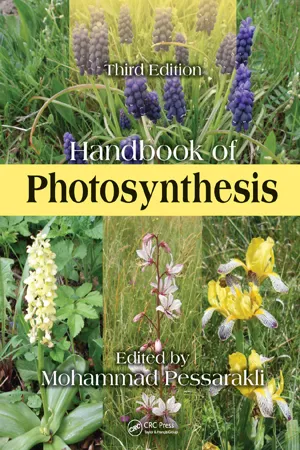
Handbook of Photosynthesis
Mohammad Pessarakli, Mohammad Pessarakli
- 846 pagine
- English
- ePUB (disponibile sull'app)
- Disponibile su iOS e Android
Handbook of Photosynthesis
Mohammad Pessarakli, Mohammad Pessarakli
Informazioni sul libro
Since the publication of the previous editions of the Handbook of Photosynthesis, many new ideas on photosynthesis have emerged in the past decade that have drawn the attention of experts and researchers on the subject as well as interest from individuals in other disciplines. Updated to include 37 original chapters and making extensive revisions to the chapters that have been retained, 90% of the material in this edition is entirely new.
With contributions from over 100 authors from around the globe, this book covers the most recent important research findings. It details all photosynthetic factors and processes under normal and stressful conditions, explores the relationship between photosynthesis and other plant physiological processes, and relates photosynthesis to plant production and crop yields.
The third edition also presents an extensive new section on the molecular aspects of photosynthesis, focusing on photosystems, photosynthetic enzymes, and genes. New chapters on photosynthesis in lower and monocellular plants as well as in higher plants are included in this section.
The book also addresses growing concerns about excessive levels and high accumulation rates of carbon dioxide due to industrialization. It considers plant species with the most efficient photosynthetic pathways that can help improve the balance of oxygen and carbon dioxide in the atmosphere.
Completely overhauled from its bestselling predecessors, the Handbook of Photosynthesis, Third Edition provides a nearly entirely new source on the subject that is both comprehensive and timely. It continues to fill the need for an authoritative and exhaustive resource by assembling a global team of experts to provide thorough coverage of the subject while focusing on finding solutions to relevant contemporary issues related to the field.
Domande frequenti
Informazioni
Section II
Biochemistry of Photosynthesis
5 Development of Chloroplast
CONTENTS
5.1 INTRODUCTION
Indice dei contenuti
- Cover
- Half Title
- Title Page
- Copyright Page
- Dedication
- Table of Contents
- Preface
- Acknowledgments
- Editor
- Contributors
- Section I Principles of Photosynthesis
- Section II Biochemistry of Photosynthesis
- Section III Molecular Aspects of Photosynthesis: Photosystems, Photosynthetic Enzymes and Genes
- Section IV Atmospheric and Environmental Factors Affecting Photosynthesis
- Section V Photosynthetic Pathways in Various Crop Plants
- Section VI Photosynthesis in Lower and Monocellular Plants
- Section VII Photosynthesis in Higher Plants
- Section VIII Photosynthesis and Plant/Crop Productivity and Photosynthetic Products
- Section IX Photosynthesis and Plant Genetics
- Section X Photosynthetic Activity Measurements and Analysis of Photosynthetic Pigments
- Section XI Photosynthesis and Its Relationship with Plant Nutrient Elements
- Section XII Photosynthesis under Environmental Stress Conditions
- Section XIII Photosynthesis in the Past, Present, and Future Prospective
- Index